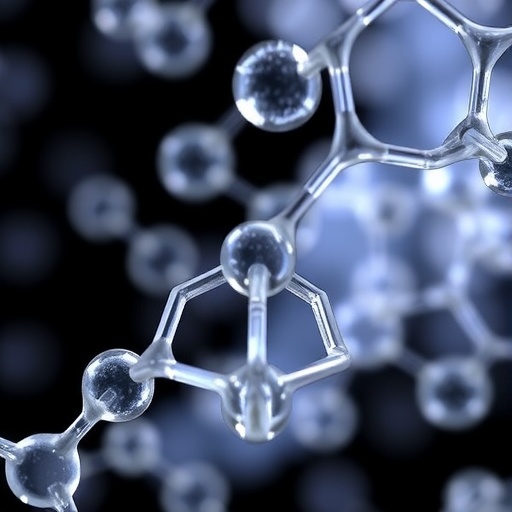Recent advances in polymer electrolytes have brought significant improvements in energy storage and conversion technologies. A groundbreaking study by Aziz, Muhammed, and Omar et al. has delved into the intricacies of ion dynamics and electrical dielectric properties in MC:NaF polymer electrolytes with the novel incorporation of glycerol. This study, published in the journal Ionics, highlights the transformative potential of glycerol as a plasticizer in enhancing the performance of polymer electrolyte systems.
Understanding the fundamental role of polymer electrolytes is crucial in the development of batteries, fuel cells, and supercapacitors. These materials serve as the medium for ion transport, which is essential for the functioning of electrochemical devices. The conventional methods of improving ionic conductivity often center around the selection of polymer matrices and salt concentrations. However, the incorporation of plasticizers like glycerol could represent a paradigm shift by providing additional pathways for ionic conduction and enhancing the overall performance of polymer electrolytes.
The research meticulously investigates the modulation of ion dynamics when glycerol is introduced into the MC:NaF polymer system. Glycerol, known for its low viscosity and high dielectric constant, offers an interesting interaction with the polymer host and the salt. This study elucidates how glycerol can disrupt the crystallinity of the polymer matrix, thereby increasing the amorphous phase that favors ionic movement. The enhanced ionic mobility is vital for improving the ionic conductivity of the electrolyte, which directly impacts the efficiency of applications such as lithium-ion batteries.
Throughout the study, Aziz and colleagues employed advanced characterization techniques to explore the dielectric characteristics of the modified polymer electrolytes. Techniques such as impedance spectroscopy and Fourier-transform infrared spectroscopy were utilized to provide insights into the ionic transport mechanisms. The data revealed a tangible correlation between glycerol concentration and the change in dielectric properties, suggesting that optimal glycerol content can tune the dielectric constant to enhance the electrolyte’s performance.
Moreover, the study emphasizes the importance of maintaining a balance between ionic conductivity and mechanical integrity. While the addition of glycerol significantly boosts ionic transport, excessive amounts may lead to issues such as leaching or structural weakness. The team performed a series of mechanical tests to determine the tensile strength and flexibility of the polymer electrolytes with varying glycerol contents. Results indicated that there is indeed a threshold in glycerol concentration beyond which mechanical properties deteriorate, hence the need for precise formulation.
In exploring the implications of their findings, the researchers noted the potential for improved energy density and power capabilities in energy storage devices if glycerol-enhanced polymer electrolytes are implemented. This innovation could extend the longevity of batteries and supercapacitors, translating into more efficient energy systems. The green credentials of glycerol as a renewable resource also align well with sustainable practices in materials science, making it a compelling choice for the next generation of energy storage technologies.
The research results also present broader implications for the field of electrochemistry. By demonstrating a viable method for enhancing ion dynamics through material modification, Aziz et al. have opened up new avenues for exploring other plasticizers and additives that could synergistically improve the performance of various polymer-based systems.
Furthermore, this breakthrough prompts a reevaluation of existing polymer electrolyte systems that may benefit from similar modification strategies. There is a wealth of different polymers and ionic salts that could be investigated under analogous conditions to glycerol incorporation. Future studies might explore how other plasticizers affect the ionic transport mechanisms, potentially leading to further advancements in this field.
It’s also crucial to note that the methodology detailed in this study can serve as a blueprint for future research endeavors. The combination of various characterization techniques not only validates the findings but also enhances reproducibility in subsequent investigations. Other teams may adopt this multidisciplinary approach, incorporating physical, chemical, and mechanical evaluations to arrive at comprehensive insights into polymer electrolyte systems.
The discovery of glycerol’s effects on ion dynamics and dielectric properties paves the way for innovative engineering applications beyond conventional batteries. With further refinement and research, we may soon see these materials play a vital role in shaping the future of hybrid electric vehicles, smart grid storage, and even wearable electronics where high-performance energy systems are essential.
Conclusively, Aziz, Muhammed, and Omar et al. provide a significant contribution to materials science and energy storage technology with their findings on MC:NaF polymer electrolytes. Their work not only lays the groundwork for further exploration into glycerol and other plasticizers but also highlights the potential for advancing sustainable energy solutions through innovative materials. As the demand for efficient and sustainable energy systems continues to escalate, studies like this become increasingly important in addressing the challenges of energy storage in modern society.
In summary, the modulation of ion dynamics and electric characteristics through glycerol incorporation in polymer electrolytes represents a promising frontier in energy technology. This research showcases a successful intersection of chemistry and engineering that could have lasting impacts on the energy landscape.
Subject of Research: Polymer electrolytes and the incorporation of glycerol to modulate ion dynamics and dielectric characteristics.
Article Title: Modulation of ion dynamics and electrical dielectric characteristics in MC:NaF polymer electrolytes through glycerol incorporation.
Article References:
Aziz, S.B., Muhammed, A.W., Omar, S.Y. et al. Modulation of ion dynamics and electrical dielectric characteristics in MC:NaF polymer electrolytes through glycerol incorporation.
Ionics (2025). https://doi.org/10.1007/s11581-025-06546-0
Image Credits: AI Generated
DOI: https://doi.org/10.1007/s11581-025-06546-0
Keywords: Polymer electrolytes, ion dynamics, dielectric properties, glycerol incorporation, energy storage.




